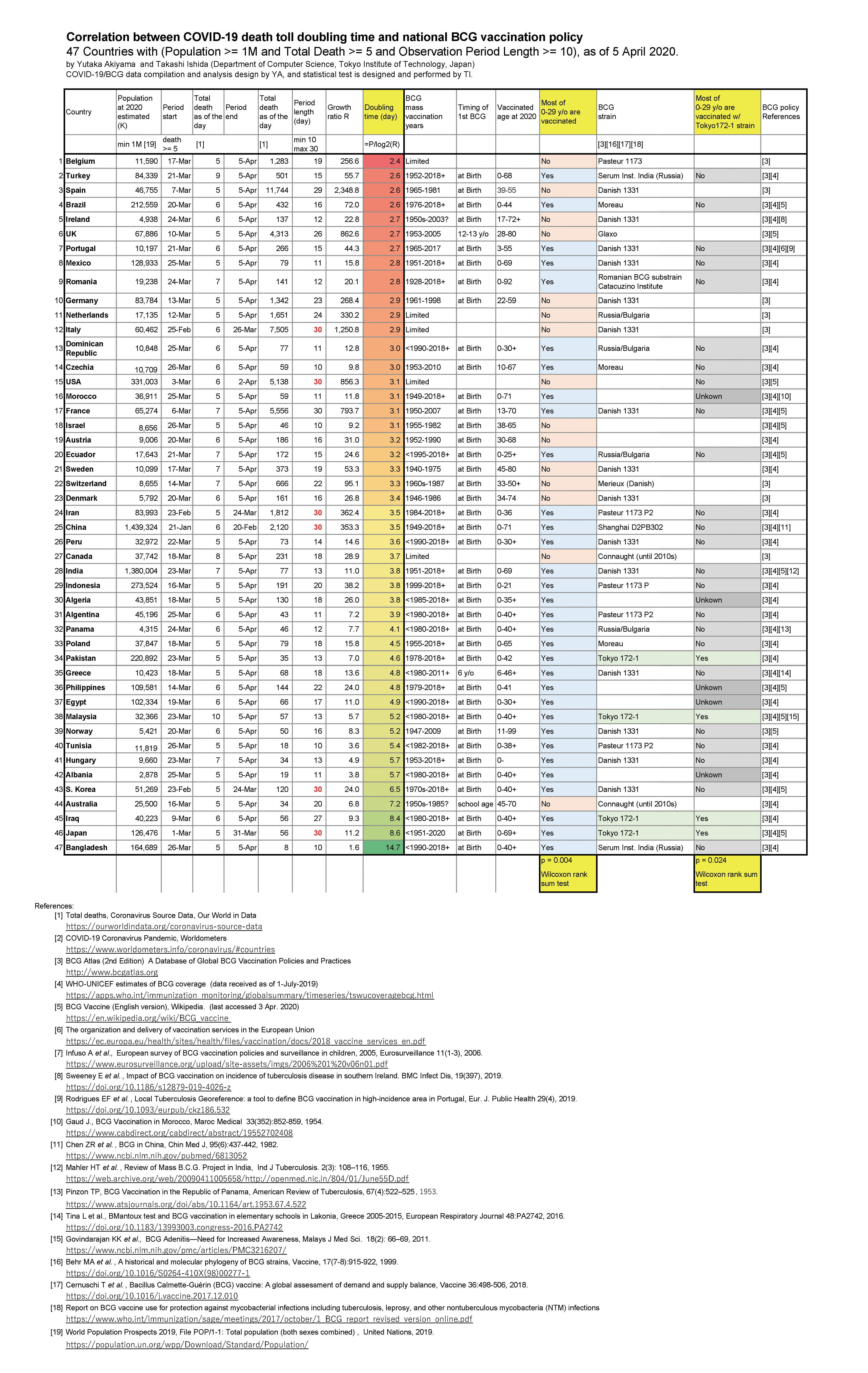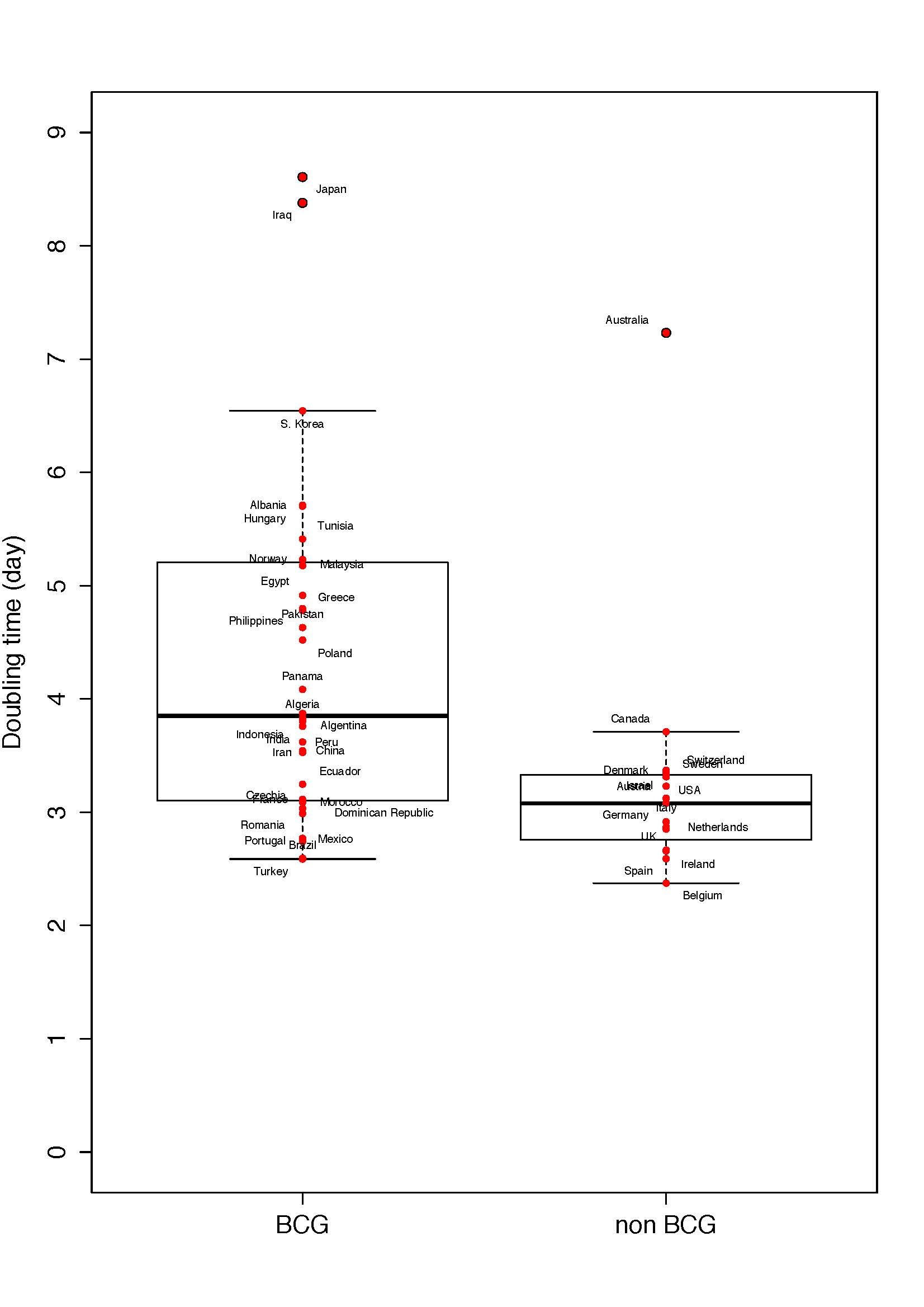Relationship between COVID-19 death toll doubling time and national BCG vaccination policy
Yutaka Akiyama* and Takashi Ishida (*Email: akiyama(at)c.titech.ac.jp)
Department of Computer Science, School of Computing, Tokyo Institute of Technology
W8-76 2-12-1 Ookayama, Meguro-ku, Tokyo 152-8550, Japan
The non-specific effects of Bacillus Calmette-Guerin (BCG) vaccination have been enthusiastically discussed [1]. Miller et al. reported the relationship between BCG vaccination and mortality for COVID-19 based on deaths per million inhabitants [2]. However they did not take into account the differences in COVID-19 detection rates among the countries and the epidemic stages of the countries. Therefore we used a doubling time (DT) of the death toll as a more stable indicator.
First, we investigated the DT of COVID-19 deaths in 47 countries (source: Our World in Data [3], as of 5 April 2020). We defined the baseline date of each country as the date when fatalities of at least five people was first observed in the country. We covered all countries that have at least 10-day observation period and had a population of more than 1 million. To exclude the effect of social interventions, the death toll data of the country was truncated by 30 days after the baseline date (for China, South Korea, Iran, Italy, Japan, and USA).
Next, we surveyed the national BCG vaccination policies of each country (sources: BCG Atlas [4], WHO-UNICEF report [5], and other 12 papers). The 47 countries were divided into two groups based on whether the majority of the population between the ages of 0 and 29 was vaccinated ("BCG") or not ("non-BCG"). BCG vaccination records are reliable only for the last 30 years for several countries.
Figure shows the distributions of DTs. Most of DTs for 32 "BCG" countries are longer than 15 "Non-BCG" (the median of the DTs are 3.9 and 3.1, respectively.) The variance of DTs of "BCG" countries was large (σ = 2.4) while DTs of "Non-BCG" are almost concentrated (σ = 1.1) in the short DT region. Based on Wilcoxson rank-sum test, the distributions of these two groups were significantly different at the significance level of 0.05 (p = 0.004).
We also investigated the dependency of the BCG strains. Among the 32 "BCG" countries, the median DT of the four countries using "Tokyo 172-1" strain (Japan, Iraq, Malaysia, and Pakistan) was 6.8, and that of the other 28 vaccinated countries was 3.8. Their distributions were also significantly different at the significance level of 0.05 (p = 0.024).
We showed a statistically significant difference of the doubling times of the death toll between "BCG" and "non-BCG" countries. The correlation might be a spurious and does not directly imply causality.
Data and full references used in the analysis are shown in Table and Figure section.
Table and Figure


References
- Moorlag SJCFM, Arts RJW, van Crevel R, Netea MG. Non-specific effects of BCG vaccine on viral infections. Clin Microbiol Infect. 2019; 25(12):1473–1478.
https://doi.org/10.1016/j.cmi.2019.04.020 - Miller A, Reandelar MJ, Fasciglione K, Roumenova V, Li Y, Otazu GH. Correlation between universal BCG vaccination policy and reduced morbidity and mortality for COVID-19: an epidemiological study. medRxiv, 2020.03.24.20042937.
https://doi.org/10.1101/2020.03.24.20042937 (accessed 5 April 2020) - Total deaths, Coronavirus Source Data, Our World in Data (Release 5 April 2020).
https://ourworldindata.org/coronavirus-source-data (accessed 5 April 2020) - BCG Atlas (2nd Edition) - A Database of Global BCG Vaccination Policies and Practices.
http://www.bcgatlas.org (accessed 5 April 2020) - WHO-UNICEF estimates of BCG coverage.
https://apps.who.int/immunization_monitoring/globalsummary/timeseries/tswucoveragebcg.html (accessed 5 April 2020)
Supplementary data
The excel file of Table is available here